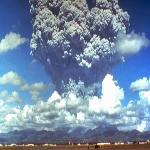August 09, 2011

Photo: USGS
Mt. Pinatubo eruption plume
A recent study finds tiny particles suspended high in Earth's atmosphere are having a greater impact on global climate than previously believed.
The airborne particles, known as aerosols, are blocking radiation from the sun, and that's cooling the Earth's surface. According to an international team of climate researchers, this cooling has been significant enough over the past decade to slow human-induced global warming.
Predicting future weather events has always been an uncertain affair, but for climate scientists today, one thing is certain: the earth's atmosphere is getting hotter. Global average temperatures have risen steadily during the past century, due largely to the rising concentration of CO2 and other industrial greenhouse gas emissions.
But John Daniel, climate scientist at the federal government's National Oceanic and Atmospheric Administration in Colorado, says a closer look at the data over the past decade revealed an anomaly.
"Since about 2001, it appears that the globally-averaged temperature has stopped going up as fast as it was going up in the decades before," Daniel said.
Meaning that the Earth is still warming, but at a slower-than-expected-pace. Daniel says neither climate scientists nor computer climate models predicted the slowdown. So Daniel, along with his U.S. and French collaborators, began to study systems that are not typically considered in atmospheric models, processes that could explain the slowing of the temperature increase.
"We also noticed that if you look at satellite observations, and you can also look at ground based observations from [the Hawaiian mountaintop observatory at] Mauna Loa, you see that stratospheric aerosols have been going up over this period. A lot of people in their models, after about the year 2000, neglected the impact of stratospheric aerosols," Daniel said.
Most of us are familiar with low-altitude aerosols: soot and other fine particulates from factories and vehicles that make up city smog. But Daniel says that unlike global-warming culprits such as atmospheric carbon dioxide, high-altitude aerosols actually cool the planet.
"The reason that these aerosols exert a cooling influence is because they reflect sunlight back to space that would have made it to the ground. Our understanding that stratospheric aerosols cool is not new. We've known that for a long time," Daniel said.
So why weren't climate scientists accounting for the stratospheric aerosols in the first place? Although they are common closer to Earth, they are less abundant in the stratosphere. Terry Deshler, Professor of Atmospheric Sciences at the University of Wyoming, explains.
"So a volcano such as [Mount] Pinatubo [in the Phillipines] threw a lot of aerosol particles up into the stratosphere and those probably were gone in about one year. But it also threw up a lot of sulfur gas. And all the sulfur in the stratosphere gets converted into sulfuric acid droplets. These particles are so small that gravity has a very slow [small] role so that the aerosol from the Pinatubo eruption persisted in the stratosphere for about five or six years," Deshler said.
Deshler, who was not involved in the new aerosol study, says explosive volcanic events comparable to the Mt. Pinatubo eruption in 1991 are rare. Five to six years after the Pinatubo eruption, climate modelers assumed the cooling effect from stratospheric aerosols had returned to the negligible levels recorded before the eruption.
But the stratospheric aerosol levels didn't return to zero. Daniel found that they have increased over the past decade even without a major eruption. He wondered if this was the reason for the slowdown in atmospheric warming.
"We calculated the temperature increase you get from the early 2000s to 2010, (first) when you neglect stratospheric aerosols and [again] when you include the aerosols. We found t hat when you include the stratospheric aerosols, you actually get about a 20% reduction in the amount of warming you would have had over that period," Daniel said.
The increase in stratospheric aerosols accounted for the reduction in temperature increase over the past decade. But Daniel and Deshler point out that it's difficult to tell where the background stratospheric aerosols are coming from. Some scientists suggest the source could be smaller, more persistent volcanic eruptions. Others suggest industrial sulfur emissions.
Most climate scientists agree that the best way to combat global warming isn't to invent countermeasures. They believe the best way is to find cleaner renewable sources of energy, so we depend less on carbon-rich fossil-fuels, and avoid at least some of the expected warming over the next few decades.